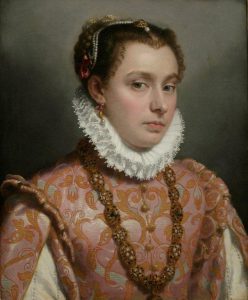
Isotta Brembati, c1555. Oil on canvas. By Giovanni Battista Moroni*.
Royal Academy showcases the brilliant Venetian portraitist Giovanni Battista Moroni, who chose to live away from Venice, By James Brewer
Giovanni Battista Moroni, pioneering master of the realist portrait, was a native of the Venetian Republic, one-time commercial mistress of the seas, but may never have worked in Venice, from where power radiated. Perhaps that was just as well for his creative peace of mind and his ability to concentrate on the work at hand, for in the 16th century La Serenissima was anything but serene.
Moroni might well have achieved more fame had he moved from Lombardy to the seaboard centre of economic frenzy, but he had commissions and subjects aplenty close to home throughout the various stages of his life.
A modern audience will be bowled over by his distinctive portraits and equally distinctive religious works. The Royal Academy of Arts in London has assembled 40 of his wonderful works, in the first such survey in the UK. A thoroughly realist painter, Moroni is ahead of other movements of the name in Europe, and as the curators put it, in his later life he was responsible for “the beginnings of modern portraiture.” He is, says the Academy, “the unsung genius of the Renaissance.”

Young Lady, c 1560-65. Oil on canvas. By Giovanni Battista Moroni. Private collection.
By the time he was born, around 1520, Venice was past its maritime zenith and had been humiliated by defeats by France, Spain and the Ottomans, by the failure of its banks, and by bubonic plague which felled thousands. The city state remained though the bulwark against the Spanish empire, which dominated much of what was to become the modern state of Italy – formal ratification of Spanish control of Italy came in 1559. The strong presence of Spaniards and others sympathetic to imperial Spain in the region is reflected in the number of them who sat for Moroni.
He was born in the small town of Albino, near Bergamo, a stronghold which had been captured by the Republic of Venice in 1428 from Milan, but which continued to look to Milan as its big brother city.
Moroni worked in Bergamo, Brescia, Trent (which, hosting the Counter-Reformation Council of Trent, was pretty well the capital of Europe at the time) and finally returned to Albino.
Venice is never in the picture – but, except in his didactic alterpieces and some of the representations of Spanish aristocrats, Moroni applies his colour with all the brilliance of Venetian painting. Writers, state officers and unusually for a painture of his stature, artisans, appeared before him, and he saw it “as it is” in contrast to the more idealised representations of his Venetian contemporary Titian (who was a fan of Moroni).

The Tailor, c 1570. Oil on canvas. By Giovanni Battista Moroni. National Gallery, London. Photo c National Gallery.
He has left us a glowing record of the fashions of the time, so that today the sumptuous silks worn in the portraits of the poet Isotta Brembati (c 1555) and Gian Gerolamo Grumelli (c 1560) draw the eye away from the fact that staying true to life, he shows their visages unflatteringly. The lush textiles reinforce the immediacy of the work, and are meant to underline the wealth and intellect of those in the picture, although behind the scenes the families of these people are feuding to the point of assassination and exile.
In the religious paintings a worshipper from real life is sometimes shown praying before a sacred scene he is said to have called to mind as encouraged by Counter-Reformation theology, as demonstrated by The Last Supper (c 1566-1569) and A Gentleman in Adoration before the Baptism of Christ (c.1555-1560). His didactic altarpieces from the churches of the Diocese of Bergamo, such as painting Saint Gotthard Enthroned with Saint Lawrence and Saint Catherine of Alexandria (c.1575), have a touch that is almost as fresh.
His portrait of The Tailor (1565-1570), one of his best known, although said to have trodden new Renaissance ground in dignifying manual labour, probably symbolises the importance of this craft in an era of gorgeous clothing, which Moroni himself clearly gloried in depicting. The garb of this particular tailor indicates that he was making a good profit from his trade.

Gian Gerolamo Grumelli, c 1560. Oil on canvas. By Giovanni Battista
The naturalism and vitality of Moroni came to be recognised in the 19th century, exemplified by the purchase in 1876 by the National Gallery in London of Portrait of a Lady (c 1556-60) and A Knight with a Jousting Helmet (c 1556), Now in the 21st century he has been placed firmly back in fashion.
With excellent introductions and labelling, the new exhibition is magnificently curated – one of the galleries seeks to emulate a room of a Bergamo palazzo – by Simone Facchinetti, curator of the Museo Adriano Bernareggi in Bergamo, and Royal Academy curator Arturo Galansino.
Giovanni Battista Moroni is on show at the Sackler Wing of the Royal Academy until January 25 2015.
*Full Caption of Pict one:Isotta Brembati, c1555. Oil on canvas. By Giovanni Battista Moroni. Fondazione Museo di Palazzo Moroni – Lucretia Moroni Collection, Bergamo. Photo Marco Mazzoleni.
**Full caption of picture four: Gian Gerolamo Grumelli, c 1560. Oil on canvas. By Giovanni Battista Moroni.Fondazione Museo di Palazzo Moroni – Lucretia Moroni Collection, Bergamo. Photo Marco Mazzoleni.





